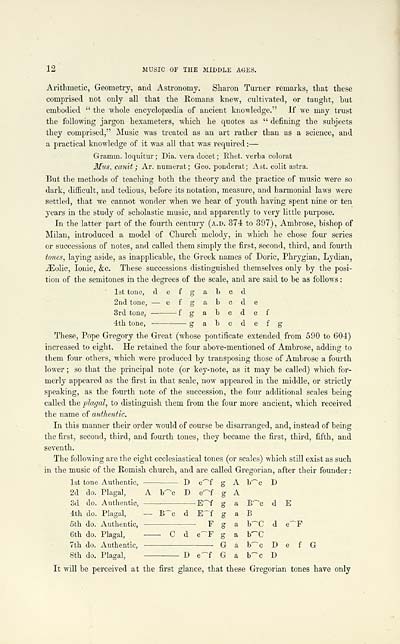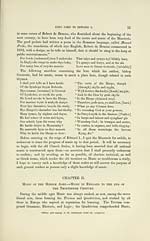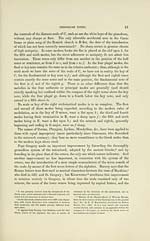Glen Collection of printed music > Printed text > Popular music of the olden time > Volume 1
(46) Page 12
Download files
Complete book:
Individual page:
Thumbnail gallery: Grid view | List view

12 MUSIC OF THE MIDDLE AGES.
Arithmetic, Geometry, and Astronomy. Sharon Turner remarks, that these
comprised not only all that the Romans knew, cultivated, or taught, but
embodied " the whole encyclopiedia of ancient knowledge." If we may trust
the following jargon hexameters, which he quotes as " defining the subjects
they comprised," Music was treated as an art rather than as a science, and
a practical knowledge of it was all that was required : —
Gramm. loquitur ; Dia. vera docet ; Rhet. verba colorat
3Ius. canit ; Ar. numerat; Geo. ponderat; Ast. colit astra.
But the methods of teaching both the theory and the practice of music were so
dark, difficult, and tedious, before its notation, measure, and harmonial laws were
settled, that we cannot wonder when we hear of youth having spent nine or ten
years in the study of scholastic music, and apparently to very little purpose.
In the latter part of the fourth century (a.d. 374 to 397), Ambrose, bishop of
Milan, introduced a model of Church melody, in which he chose four series
or successions of notes, and called them simply the first, second, third, and fourth
tones, laying aside, as inapplicable, the Greek names of Doric, Phrygian, Lydian,
^olic, Ionic, &c. These successions distinguished themselves only by the posi-
tion of the semitones in the degrees of the scale, and are said to be as follows :
Ist tone, defgabcd
2nd tone, — efgabode
3rd tone, — f g a b c d e f
4:th tone, gabcdefg
These, Pope Gregory the Great (whose pontificate extended from 590 to 604)
increased to eight. He retained the four above-mentioned of Ambrose, adding to
them four others, which were produced by transposing those of Ambrose a fourth
lower ; so that the principal note (or key-note, as it may be called) which for-
merly appeared as the first in that scale, now appeared in the middle, or strictly
speaking, as the fourth note of the succession, the four additional scales being
called the plagal, to distinguish them from the four more ancient, which received
the name of authentic.
In this manner their order would of course be disarranged, and, instead of being
the first, second, third, and fourth tones, they became the first, third, fifth, and
seventh.
The following are the eight ecclesiastical tones (or scales) which still exist as such
in the music of the Romish church, and are called Gregorian, after their founder :
1st tone Authentic,
2d do. Plagal,
3d do. Authentic, E'^f k a B'^^c d E
4th do. Plagal,
5th do. Authentic,
6th do. Plagal,
7th do. Authentic, Gab'^cDefG
8th do. Plagal,
It will be perceived at the first glance, that these Gregorian tones have only
D
e^f
A b-^c
D
e""f
— B~c
d
E~f
C
d
e~F
D
e~f
g
A
K^c
D
g
A
g
a
B'-^c
d
g
a
B
g
a
b-C
d
g
a
b-^c
G
a
b-c
D
G
a
b"c
D
Arithmetic, Geometry, and Astronomy. Sharon Turner remarks, that these
comprised not only all that the Romans knew, cultivated, or taught, but
embodied " the whole encyclopiedia of ancient knowledge." If we may trust
the following jargon hexameters, which he quotes as " defining the subjects
they comprised," Music was treated as an art rather than as a science, and
a practical knowledge of it was all that was required : —
Gramm. loquitur ; Dia. vera docet ; Rhet. verba colorat
3Ius. canit ; Ar. numerat; Geo. ponderat; Ast. colit astra.
But the methods of teaching both the theory and the practice of music were so
dark, difficult, and tedious, before its notation, measure, and harmonial laws were
settled, that we cannot wonder when we hear of youth having spent nine or ten
years in the study of scholastic music, and apparently to very little purpose.
In the latter part of the fourth century (a.d. 374 to 397), Ambrose, bishop of
Milan, introduced a model of Church melody, in which he chose four series
or successions of notes, and called them simply the first, second, third, and fourth
tones, laying aside, as inapplicable, the Greek names of Doric, Phrygian, Lydian,
^olic, Ionic, &c. These successions distinguished themselves only by the posi-
tion of the semitones in the degrees of the scale, and are said to be as follows :
Ist tone, defgabcd
2nd tone, — efgabode
3rd tone, — f g a b c d e f
4:th tone, gabcdefg
These, Pope Gregory the Great (whose pontificate extended from 590 to 604)
increased to eight. He retained the four above-mentioned of Ambrose, adding to
them four others, which were produced by transposing those of Ambrose a fourth
lower ; so that the principal note (or key-note, as it may be called) which for-
merly appeared as the first in that scale, now appeared in the middle, or strictly
speaking, as the fourth note of the succession, the four additional scales being
called the plagal, to distinguish them from the four more ancient, which received
the name of authentic.
In this manner their order would of course be disarranged, and, instead of being
the first, second, third, and fourth tones, they became the first, third, fifth, and
seventh.
The following are the eight ecclesiastical tones (or scales) which still exist as such
in the music of the Romish church, and are called Gregorian, after their founder :
1st tone Authentic,
2d do. Plagal,
3d do. Authentic, E'^f k a B'^^c d E
4th do. Plagal,
5th do. Authentic,
6th do. Plagal,
7th do. Authentic, Gab'^cDefG
8th do. Plagal,
It will be perceived at the first glance, that these Gregorian tones have only
D
e^f
A b-^c
D
e""f
— B~c
d
E~f
C
d
e~F
D
e~f
g
A
K^c
D
g
A
g
a
B'-^c
d
g
a
B
g
a
b-C
d
g
a
b-^c
G
a
b-c
D
G
a
b"c
D
Set display mode to: Large image | Transcription
Images and transcriptions on this page, including medium image downloads, may be used under the Creative Commons Attribution 4.0 International Licence unless otherwise stated. ![]()
| Special collections of printed music > Glen Collection of printed music > Printed text > Popular music of the olden time > Volume 1 > (46) Page 12 |
|---|
| Permanent URL | https://digital.nls.uk/91367999 |
|---|
| Shelfmark | Glen.254 |
|---|---|
| Additional NLS resources: | |
| Attribution and copyright: |
|
| Description | Scottish songs and music of the 18th and early 19th centuries, including music for the Highland bagpipe. These are selected items from the collection of John Glen (1833 to 1904). Also includes a few manuscripts, some treatises, and other books on the subject. |
|---|
| Description | The Glen Collection and the Inglis Collection represent mainly 18th and 19th century Scottish music, including Scottish songs. The collections of Berlioz and Verdi collected by bibliographer Cecil Hopkinson contain contemporary and later editions of the works of the two composers Berlioz and Verdi. |
|---|

